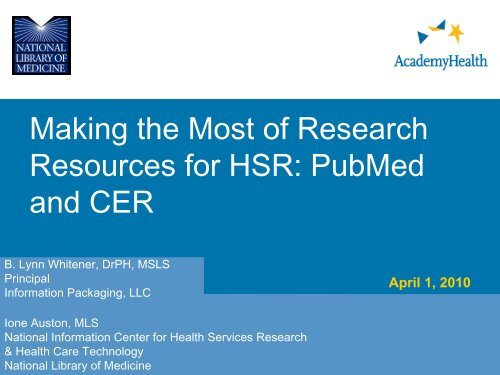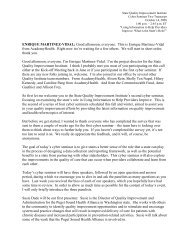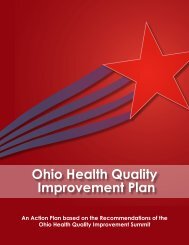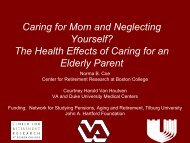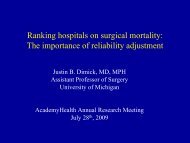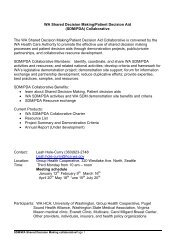Welcome to Chicago!
PubMed
PubMed
You also want an ePaper? Increase the reach of your titles
YUMPU automatically turns print PDFs into web optimized ePapers that Google loves.
Making the Most of Research<strong>Welcome</strong> Resources for <strong>to</strong> HSR: <strong>Chicago</strong>! PubMedand CERB. Lynn Whitener, DrPH, MSLSPrincipalInformation Packaging, LLCApril 1, 2010Ione Aus<strong>to</strong>n, MLSNational Information Center for Health Services Research& Health Care TechnologyNational Library of Medicine
<strong>Welcome</strong>Beth Johnson, MPHAssociateAcademyHealth
Today’s Webinar AcademyHealth– The professional society of health servicesresearch and health policy analysis– Visit: www.academyhealth.org National Library of Medicine– Health Services Research Information Program– National Information Center on Health ServicesResearch and Health Care Technology (NICHSR)– Visit: www.nlm.nih.gov/hsrhp.html
Learning ObjectivesProvide an overview of search filtersthat will aid in searches on HSRrelated<strong>to</strong>pics.Explore PubMed filters developedspecifically for HSR and comparativeeffectiveness.Demonstrate the utility and usefulnessof these search filters.
Submitting QuestionsTo submit a question:1) Click on the Chat “bubble” icon shownon the right. This opens the chatwindow on your system only.2) Type your question in<strong>to</strong> the dialog boxand click the ‘Send’ but<strong>to</strong>n.- Please submit questions <strong>to</strong> theAcademyHealth Modera<strong>to</strong>r.- Questions sent <strong>to</strong> the host orpresenter will not be received by themodera<strong>to</strong>r and therefore will not beanswered.
Webinar Audio Audio for this presentation isstreamed through the“Audio Broadcast” player If you do not hear any audio now, check yourcomputer’s speaker settings and volume Alternatively, you may connect <strong>to</strong> theteleconference by dialing (866) 699-3239– Meeting/Event number: 793 280 624– Press pound (#) when prompted for your attendeeID number
Support Contact WebEx’s tech supportby calling 1-866-229-3239
FacultyB. Lynn Whitener, DrPH, MSLSPrincipalInformation Packaging, LLC
FacultyIone Aus<strong>to</strong>n, MLSLibrarianNational Information Center onHealth Services Research &Health Care Technology (NICHSR)National Library of Medicine
PubMed HSR Filters
Learning Objectives• awareness of Health Services Research• introduction <strong>to</strong> PubMed Filters forHealth Services Research and Comparative Effectiveness Research• ability <strong>to</strong> use PubMed Filters appropriately
Whether at the level of an individual patient and a clinicianconfronting discrete care choices, a medical direc<strong>to</strong>r of amanaged care plan caring for a defined population, a Stateofficial addressing the health needs of entire communities, orpublic and private purchasers seeking value for their healthcare dollar, health services research answers the enduringcentral questions: What works? Under what circumstances? Forwhich conditions? At what cost?John Eisenberg MD
Justification for Budget Estimates for AppropriationsCommittees, Fiscal Year 1999.Agency for Health Care Policy and Research, Rockville,MD.http://www.ahrq.gov/about/cj1999/cjweb99.htm
Health Services ResearchAcademyHealth• social fac<strong>to</strong>rs• financing systems• organizational structures & processes• health technologies• personal behaviors
Health Services ResearchAcademyHealth• access <strong>to</strong> health care• quality and cost of health care• our health and well-being
Health Services Research - A His<strong>to</strong>rical Perspective VideoNLM commissioned as part of its effort <strong>to</strong> document thehis<strong>to</strong>ry of Health Services Research (HSR)http://www.nlm.nih.gov/nichsr/outreach.html#video1
Specialized Search Filters
Why filters?• who is the audience?• what can filters do?
Intended audience• researchers• clinicians• health policy analysts• planners
Intended use• entry points for busy people• use “Related articles” with likely citations• use “Advanced search” <strong>to</strong> combine or limit sets
Specialized Health Services Research searchesTwo main themes• four health care quality categories• two health care cost categories
Four health care quality categories• appropriateness• process assessment• outcome assessment• qualitative studies
Two health care costs categories• cost• economics
Appropriateness• appropriate clinical indications <strong>to</strong> receive that serviceMethodological criteria• data source was independent of the study investiga<strong>to</strong>rs• application of the criteria was reliable• audi<strong>to</strong>rs were blind <strong>to</strong> practitioner identity• audi<strong>to</strong>rs were blind <strong>to</strong> institution identity
AppropriatenessOptimized forPubMed Equivalentsensitive/broadinappropriate [tiab]or records [mh]specific/narrowappropriateness[tiab]
Process Assessment• what, <strong>to</strong> whom, why, where, when and how wellMethodological criteria:• data source is independent of the study investiga<strong>to</strong>r• application of the criteria was reliable• audi<strong>to</strong>rs were blind <strong>to</strong> practitioner identity• audi<strong>to</strong>rs were blind <strong>to</strong> institution identity
Process AssessmentOptimized forPubMed Equivalentsensitive/broadhealth servicesadministration[mh] ORtherapy[sh:noexp] ORadjusted[tiab]specific/narrowpractice*[tiab] ORadjusted[tiab]
Outcomes Assessment• clinical decisions/management paths• effects on patient well-being (outcomes)Methodological criteria:• at least one of the outcomes is objective• derived from a data source that is independent of the study
Outcomes AssessmentOptimized forPubMed Equivalentsensitive/broadhealth servicesadministration[mh]OR epidemiologicstudies[mh] ORepidemiology[sh]specific/narrowsurvival[tiab] ORmortality[mh]
Costs• costs or financing of a health care issueMethodological criteria:• none
CostsOptimized forPubMed Equivalentsensitive/broadcost[tiab] OR costs[tiab] OR costsand cost analysis[mh] OR ec[sh]specific/narrowcost effectiveness*[tiab] ORsaves[tiab] OR savings[tiab]saved[tiab] OR saver[tiab] ORsavers[tiab] OR save[ti] ORsaving[ti] OR (save[tw] ORsaving[tw]) AND (ec[sh] OReconomic OR dollar* OR moneyOR cost OR costs OR costing ORsocioeconomic OR inexpensive ORefficiency OR financ* OR treatmen<strong>to</strong>utcome)
Economics• comparison of the cost and effects of at least twodifferent forms of service provision
Methodological criteria:• comparison of alternatives• balancing effectiveness and costs• estimates based on individual patient data• incremental or additional costs and outcomes of oneintervention over another• sensitivity analysis performed if there is uncertainty• evidence from a methodologically rigorous study ofdiagnosis, treatment, quality improvement or a systematicreview article that involved real patients
EconomicsOptimized forPubMed Equivalentsensitive/broadcosts[tiab] OR cost effective[tiab]OR economic[tiab]specific/narrowcost effective[tiab] ORsensitivity analys*[tiab] OR costeffectiveness[tiab]
Qualitative Studies• how people feel or experience certain situations• data collection methods and analyses are appropriateMethodologic criteria:• none
Qualitative StudiesOptimized forPubMed Equivalentsensitive/broadinterview*[tiab] ORpsychology[sh:noexp] OR healthservices administration[mh]specific/narrowqualitative[tiab] OR themes[tiab]
Practice Searches forComparison
Patient Safety ResultsPubMed = 106628HSR Queriesappropriateness, broad, sensitive search = 2576appropriateness, narrow, specific search = 256
Patient Safety ResultsPubMed = 106628HSR Queriescosts, broad, sensitive search = 7607costs, narrow, specific search = 1966
HSR Search Algorithms
Summary of Enhancements for Clinical Queries forMEDLINE for Studieshttp://www.nlm.nih.gov/pubs/techbull/jf04/cq_info.html
More detailsWilczynski NL, Haynes RB, Lavis JN,Ramkissoonsingh R, Arnold-Oatley AE;HSR Hedges team.Optimal search strategies for detecting healthservices research studies in MEDLINE.CMAJ2004 Nov 9;171(10):1179-85.PMID: 15534310PMCID: PMC524948
More detailsWong SS, Wilczynski NL, Haynes RB; Hedges Team.Developing optimal search strategies for detectingclinically relevant qualitative studies in MEDLINE.Stud Health Technol Inform.2004;107(Pt 1):311-6.PMID: 15360825
HSRProj and HSRRApril 15, 2010
Questions?Comments?betty.whitener@nih.gov
NLM Resources for InformingComparative EffectivenessNLM‐MLA‐AcademyHealth WebinarMaking the Most of Research Resources for HSR:PubMed and CERIone Aus<strong>to</strong>n,National Information Center onHealth Services Research & Health Care Technology(NICHSR), National Library of Medicine
Outline of discussion• What is Comparative Effectiveness Researchand why is it of interest?• Search strategies for Informing CER:AudienceHow they were developedFeedback• Sample searches
DefinitionComparative effectiveness research (CER) comparestreatments and strategies <strong>to</strong> improve health. Thisinformation is essential for clinicians and patients <strong>to</strong>decide on the best treatment. It also enables ournation <strong>to</strong> improve the health of communities and theperformance of the health system.http://www.hhs.gov/recovery/programs/cer/
Comparative EffectivenessResearch FundingThe American Recovery and Reinvestment Act(ARRA) of 2009 provides $1.1 billion for CER:– $300 million for the Agency for Healthcare Researchand Quality (AHRQ)– $400 million for the National Institutes of Health (NIH)– $400 million for the Office of the Secretary of Healthand Human Services AND– Creation of the Federal Coordinating Council forComparative Effectiveness Researchhttp://www.hhs.gov/recovery/programs/cer/
ARRA Funding for CER (cont.)These funds are <strong>to</strong> support research assessing the comparativeeffectiveness of health care treatments and strategies, throughefforts that:• Conduct, support, or synthesize research that compares the clinicaloutcomes, effectiveness, and appropriateness of items, services,and procedures that are used <strong>to</strong> prevent, diagnose, or treatdiseases, disorders, and other health conditions.• Encourage the development and use of clinical registries, clinicaldata networks, and other forms of electronic health data that can beused <strong>to</strong> generate or obtain outcomes data.http://www.hhs.gov/recovery/programs/cer/
Report <strong>to</strong> the President and the Congress onComparative Effectiveness ResearchEXECUTIVE SUMMARY (June 2009)http://www.hhs.gov/recovery/programs/cer/execsummary.htm
Initial National Priorities forComparative Effectiveness Research(IOM)http://www.hrsonline.org/Policy/LegislationTakeAction/upload/CER-report-brief-6-22-09.pdf
http://www.nih.gov/
http://report.nih.gov/rcdc/categories/
Why this project? Why NLM? WhyNow?In the short term, a Search PROBLEM:“We did a study that is comparative effectiveness research butwe didn’t think <strong>to</strong> title or describe it that way.” How would anyonefind my study? [Researcher at Agency for Healthcare Research& Quality CER Methods Symposium, 2009]NLM has vast information resources that are used worldwide inHealth Services Research and more recently in CER.NLM resources can be cus<strong>to</strong>mized <strong>to</strong> address the immediatequestions that are evolving for CER [and help people find thisresearcher’s study].
Audience for the CER search queries• Policy/Decision Makers ‐ <strong>to</strong> help inform CER• Practitioners ‐ <strong>to</strong> help awareness of CER• Health Services Researchers –<strong>to</strong> help frameCER questions• Librarians/Information Specialists
http://www.nlm.nih.gov/nichsr/cer/cerqueries.html
Conceptual organization builds on work of ErinHolve and her colleagues at AcademyHealth*• PubMed –• Clinical Studies – Randomized Controlled Trials• Observational Studies‐ Cohort, Registries, EHR’s,Administrative Data• Systematic Reviews –SR’s, Simulations, Models• Health Disparities• Costs and Cost Analysis• Comparative Effectiveness as Subject• All• HSRProj –Health Services Research Projects in progress• ClinicalTrials.gov – current, ongoing trials*Holve, E. and P. Pittman, A First Look at the Volume and Cost of ComparativeEffectiveness Research in the United States. AcademyHealth. June 2009.http://www.academyhealth.org/files/publications/CERMonograph09.pdf
Volume of Studies(2/2/10)DatabaseNumber ofRecordsCER SearchPubMed 19,485,863 1,361,053HSRProj 8,613 2,723ClinicalTrials.gov 84,926 24,599
http://www.nlm.nih.gov/nichsr/cer/cerqueries.html
Feedback FormQuestion 5:Are there otheroutcomes termsthat should beincluded ?
Sources of Terms• NLM Medical Subjects Headings (MeSH)• NLM Special Search Queries on SystematicReviews, Health Disparities, HSR Querieshttp://www.nlm.nih.gov/bsd/special_queries.html• AHRQ Evidence‐Based Practice Centers• InterTASC ISSG Search Filtershttp://www.york.ac.uk/inst/crd/intertasc/• Examination of words in titles and abstracts• Examination of study types in HSRProj• ClinicalTrials – Phase III and IV trials withActive Compara<strong>to</strong>r
NLM Medical Subject Headings(MeSH)LM has introduced the following MeSH terms in 2010 <strong>to</strong> assist in identification and retrieval of citations relating <strong>to</strong> ARRA, CER, and related research support:American Recovery and Reinvestment ActPublic Law No: 111‐5, enacted February 2009, makes supplemental appropriations for jobpreservation and creation, infrastructure investment, energy efficiency and science, assistance <strong>to</strong>the unemployed, and State and local fiscal stabilization, for fiscal year ending September 30,2009. Year introduced: 2010Comparative Effectiveness ResearchConduct and synthesis of systematic research comparing interventions and strategies <strong>to</strong> prevent,diagnose, treat, and moni<strong>to</strong>r health conditions. The purpose of this research is <strong>to</strong> inform patients,providers, and decision‐makers, responding <strong>to</strong> their expressed needs, about which interventionsare most effective for which patients under specific circumstances.(hhs.gov/recovery/programs/cer/draftdefinition.html accessed 6/12/2009)Year introduced: 2010Research Support, American Recovery and Reinvestment Act[Publication Type]Year introduced: 2010
NLM Special Search Queries on Systematic Reviews, HSRQueries, and Health Disparitieshttp://www.nlm.nih.gov/bsd/special_queries.html
InterTASC ISSG Search Filtershttp://www.york.ac.uk/inst/crd/intertasc/
What’s NOT “Actively”* Includedvia Search Strategy• Adverse Events/Effects• Diagnostic Studies• Healthcare Service Delivery, e.g., PhysicianPracticePatterns• **In‐Process Citations• **Observational Studies listed in ClinicalTrials.gov*Topics may be covered in relation <strong>to</strong> CER Search Strategies but specific targeted searches for <strong>to</strong>pic havenot been developed/included.** Work on these areas will be done in future.
(((randomized controlled trial [pt] OR clinical trial, phase iii [pt] OR clinical trial, phase iv [pt] OR clinicaltrials.gov [si] OR isrctn [si] OR randomized controlled trials as <strong>to</strong>pic[mh]) OR (clinical trial [pt] AND (((single [tw] OR double [tw] OR doubleblind [tw] OR doubleblinded [tw] OR treble [tw] OR triple [tw]) AND (blind [tw] OR blinded [tw] OR mask[tw] OR masked [tw] OR masks [tw] OR sham [tw] OR shams [tw] OR dummy [tw])) OR (random [tw] OR randomise [tw] OR randomize [tw] OR randomised [tw] ORrandomized [tw] OR rct [tw] OR rcts [tw] OR single-blind method [mh] OR double-blind method [mh] OR random allocation [mh]))) AND ((comparative study [pt] OR compare[tw] OR compares [tw] OR compared [tw] OR compared [tw] OR comparing [tw] OR comparison [tw] OR comparative [tw] OR effective [tw] OR effectiveness [tw] OR versus[ti] OR vs [ti]) OR (activities of daily living [mh] OR benefit [tw] OR benefits [tw] OR budgets [mh] OR chronic disease [mh] OR clinical trials data moni<strong>to</strong>ring committees [mh]OR cognitive function [tw] OR ec [sh] OR death [mh] OR diffusion of innovation [mh] OR discharge [tw] OR economics, pharmaceutical [mh] OR evidence based practice [mh]OR functional status [tw] OR guideline adherence [mh] OR harm [tw] OR harms [tw] OR health services research [mh] OR health status [mh] OR hospitalization [mh] ORinterventions [tw] OR life expectancy [mh] OR longevity [mh] OR models, statistical [mh] OR models, theoretical [mh:noexp] OR morbidity [mh] OR mortality [mh] ORnoninferior [tw] OR noninferiority [tw] OR outcome and process assessment [mh] OR outcome [tw] OR outcomes [tw] OR patient compliance [mh] OR pos<strong>to</strong>perative care[mh] OR pos<strong>to</strong>perative complications [mh] OR product surveillance, postmarketing [mh] OR propensity score [tw] OR quality-adjusted life years [mh] OR quality of life [mh]OR recovery of function [mh] OR recurrence [mh] OR relapse [tw]OR remission [tw] OR reoperation [mh] OR risk [tw] OR risk management [mh] OR survival analysis [mh] ORsurvival rate [mh] OR technology assessment, biomedical [mh] OR trial [ti] OR trials [ti]))) OR clinical effectiveness [tw]) OR ((case-control studies [mh] OR cohort studies[mh] OR cross-over studies [mh] OR epidemiologic studies [mh:noexp] OR cross-sectional studies [mh] OR evaluation studies as <strong>to</strong>pic [mh] OR meta-analysis as <strong>to</strong>pic [mh]OR practice guidelines as <strong>to</strong>pic [mh] OR case control [tw] OR case controlled [tw] OR case controls [tw] OR cohort [tw]OR cohorts [tw] OR follow-up [tw] OR followup [tw] ORlongitudinal [tw] OR matched-pair analysis [mh] OR observational studies [tw]OR observational study [tw] OR multicenter study [pt]) AND ((comparative study [pt] ORcompare [tw] OR compares [tw] OR compared [tw] OR compared [tw] OR comparing [tw] OR comparison [tw] OR comparative [tw] OR effective [tw] OR effectiveness [tw] ORversus [ti] OR vs [ti]) AND (activities of daily living [mh] OR benefit [tw] OR benefits [tw] OR budgets [mh] OR chronic disease [mh] OR clinical trials data moni<strong>to</strong>ringcommittees [mh] OR cognitive function [tw] OR ec [sh] OR death [mh] OR diffusion of innovation [mh] OR discharge [tw] OR economics, pharmaceutical [mh] OR evidencebased practice [mh] OR functional status [tw] OR guideline adherence [mh] OR harm [tw] OR harms [tw] OR health services research [mh] OR health status [mh] ORhospitalization [mh] OR interventions [tw] OR life expectancy [mh] OR longevity [mh] OR models, statistical [mh] OR models, theoretical [mh:noexp] OR morbidity [mh] ORmortality [mh] OR noninferior [tw] OR noninferiority [tw] OR outcome and process assessment [mh] OR outcome [tw] OR outcomes [tw] OR patient compliance [mh] ORpos<strong>to</strong>perative care [mh] OR pos<strong>to</strong>perative complications [mh] OR product surveillance, postmarketing [mh] OR propensity score [tw] OR quality-adjusted life years [mh] ORquality of life [mh] OR recovery of function [mh] OREffectivenessrecurrence [mh] OR relapse [tw]OR remission [tw] OR reoperation[sb][mh] OR risk [tw] OR risk management [mh] ORsurvival analysis [mh] OR survival rate [mh] OR technology assessment, biomedical [mh]))) OR (((administrative data [tw] OR administrative database [tw] OR administrativedatabases [tw] OR chart review [tw] OR data registry [tw] OR data registries [tw] OR databases, factual [mh] OR hospital claims [tw] OR insurance claim review [mh] ORmedical record linkage [mh] OR medical record review [tw] OR medical records systems, computerized [mh] OR national database [tw] OR observational analysis [tw] ORpatient-reported outcomes measurement information system [tw] OR promis [tw] OR patient registry [tw] OR patient registries [tw] OR practice based research network [tw]OR practice based research networks [tw] OR pbrn [tw] OR pbrns [tw] OR registries [mh]) OR (National hospital discharge survey [tw] AND sn [sh]) OR (OSCAR AND nursinghomes [tw]) OR Hospitalization/sn [majr] OR (hospitalization/td [majr] AND sn [sh])) AND (comparative study [pt] OR (activities of daily living [mh] OR benefit [tw] OR benefits[tw] OR budgets [mh] OR chronic disease [mh] OR clinical trials data moni<strong>to</strong>ring committees [mh] OR cognitive function [tw] OR ec [sh] OR death [mh] OR diffusion ofinnovation [mh] OR discharge [tw] OR economics, pharmaceutical [mh] OR evidence based practice [mh] OR functional status [tw] OR guideline adherence [mh] OR harm[tw] OR harms [tw] OR health services research [mh] OR health status [mh] OR hospitalization [mh] OR interventions [tw] OR life expectancy [mh] OR longevity [mh] ORmodels, statistical [mh] OR models, theoretical [mh:noexp] OR morbidity [mh] OR mortality [mh] OR noninferior [tw] OR noninferiority [tw] OR outcome and processassessment [mh] OR outcome [tw] OR outcomes [tw] OR patient compliance [mh] OR pos<strong>to</strong>perative care [mh] OR pos<strong>to</strong>perative complications [mh] OR product surveillance,postmarketing [mh] OR propensity score [tw] OR quality-adjusted life years [mh] OR quality of life [mh] OR recovery of function [mh] OR recurrence [mh] OR relapse [tw]ORremission [tw] OR reoperation [mh] OR risk [tw] OR risk management [mh] OR survival analysis [mh] OR survival rate [mh] OR technology assessment, biomedical [mh])))OR (registries/es [mh] OR registries/st [mh] OR registries/sn [mh] OR (registries [mh] AND (medicare [mh] OR practice guidelines as <strong>to</strong>pic [mh] ))) OR (Systematic [sb] OR(Models, statistical [majr] AND (Computer simulation [mh] OR decision support techniques [mh] OR cohort study [mh] OR costs and cost analysis [mh] OR diffusion ofinnovation [mh] OR health care reform [mh] OR healthcare costs [mh] OR health policy [mh] OR life expectancy [mh] OR life tables [mh] OR markov chains [mh] OR montecarlo method [mh] OR patient compliance [majr] OR predictive value of tests [mh] OR resource allocation [mh] OR survival analysis [mh] OR survival rate [mh])) OR (Decisionsupport techniques [majr] AND (computer simulation [mh] OR research design [mh])) OR (Mass screening [majr] AND models, statistical [mh]) OR ((Synthesis [tw] ORsimulation [tw]) AND (cohort study [mh] OR costs and cost analysis [mh] OR diffusion of innovation [mh] OR health care reform [mh] OR healthcare costs [mh] OR healthpolicy [mh] OR life expectancy [mh] OR life tables [mh] OR markov chains [mh] OR monte carlo method [mh] OR patient compliance [majr] OR predictive value of tests [mh]OR resource allocation [mh] OR survival analysis [mh] OR survival rate [mh])) OR (Cohort simulation [tw] OR cohort simulations [tw] OR decision analytic model [tw] ORdecision analytic models [tw]) OR (models, econometric [mh] OR models, economic [mh])) OR (health care reform [majr] OR healthcare disparities [majr] OR health policy[majr] OR health status disparities [majr] OR minority health [majr] OR pragmatic trial [tw] OR pragmatic trials [tw] OR practical clinical trial [tw] OR “comparativeeffectiveness” OR (promising [tw] AND unproven [tw]) OR resource allocation [majr] OR therapies, investigational [majr] OR agency for healthcare research and quality [mh]OR centers for medicare and Medicaid services [majr] OR costs and cost analysis [majr])
comparative study, RCTRCT(s) as <strong>to</strong>picRCT comparing different types of ablationRCT comparing perioperative amiodaroneSample results from Clinical Studies search
longitudinal, observational studycomparative study looking at patient selectionretrospective cohort studycomparative studySample results from Observational search
eview, evidence-based medicineevidence-based medicineSample results from Systematic Review search
Results from Health Disparities
Costs and Cost Analysis
Using PubMed His<strong>to</strong>ry feature <strong>to</strong> combinesearch results on Health Disparities and Costs
PubMed CER Searches Conceptual StructureClinicalStudiesRCTsComparativeOREffectiveOutcomesObservationalStudiesCohortAdministrativeData/Registries/EHRsComparativeOREffectiveOutcomesSystematicReviewsSystematicReviewsSimulationsModelingHealthDisparitiesCosts & CostAnalysis“About” CERALL of the AboveORAND
Suggested Reading/ResourcesAcademyHealth. Health Services Research (HSR) Methods. [Internet]http://www.hsrmethods.org/Agency for Healthcare Research and Quality. (AHRQ) Effective Health Care Program.[Internet] http://effectivehealthcare.ahrq.gov/index.cfmAus<strong>to</strong>n I. NLM Resources for Informing Comparative Effectiveness Research. [Internet]. NLMTech Bull. (Forthcoming 2010). http://www.nlm.nih.gov/pubs/techbull/Federal Coordinating Council for Comparative Effectiveness Research. Report <strong>to</strong> the Presidentand the Congress, June 30, 2009. [Internet]. Washing<strong>to</strong>n, DC: The Council; 2009 [cited 2010Mar. 14]. 73 p. http://www.hhs.gov/recovery/programs/cer/cerannualrpt.pdfHolve, E. and P. Pittman. A first look at the volume and cost of comparative effectivenessresearch in the United States [Internet]. Washing<strong>to</strong>n, DC: AcademyHealth; 2009 June [cited2010 Mar. 14]. 20 p.http://www.academyhealth.org/files/FileDownloads/AH_Monograph_09FINAL7.pdf
Suggested Reading/Resources(cont.)Institute of Medicine. Committee on Comparative EffectivenessResearch Prioritization, Initial National Priorities for ComparativeEffectiveness Research. [Internet]. Washing<strong>to</strong>n, DC: IOM; 2009 June[cited 2010 Mar. 14]http://www.nap.edu/catalog.php?record_id=12648Zwarenstein M, et al.: Improving the reporting of pragmatic trials: anextension of the CONSORT statement. BMJ 2008 Nov11;337:a2390. doi: 10.1136/bmj.a2390.http://www.bmj.com/cgi/content/full/337/nov11_2/a2390?view=long&pmid=19001484
I Thank you for joining us <strong>to</strong>day. Please try out theCER search filters and let us know what you think!Ione Aus<strong>to</strong>naus<strong>to</strong>n@nlm.nih.gov
DiscussionTo submit a question:1) Click on the Chat “bubble” icon shownon the right. This opens the chatwindow on your system only.2) Type your question in<strong>to</strong> the dialog boxand click the ‘Send’ but<strong>to</strong>n.- Please submit questions <strong>to</strong> theAcademyHealth Modera<strong>to</strong>r.- Questions sent <strong>to</strong> the host orpresenter will not be received by themodera<strong>to</strong>r and therefore will not beanswered.
Feedback Please complete the evaluation at theconclusion of this event <strong>to</strong> obtaincontinuing education credit.
National Information Center for Health ServicesResearch and Health Care Technology (NICHSR)National Library of MedicineVisit: www.nlm.nih.gov/hsrph.html
Resources AcademyHealth Research Resources– Direct access <strong>to</strong> research resources:www.academyhealth.org/researchresources• Research Resources for HSR: HSRProj, HSRR, andPubMed: www.academyhealth.org/NLMtu<strong>to</strong>rial•HSRProj: www.academyhealth.org/hsrproj•HSRR• Grey Literature• Core Library Modules•HSRMethods: www.hsrmethods.org Questions? E-mail hsrproj@academyhealth.org
Resources AcademyHealth Online Training(www.academyhealth.org/training) On-Demand Seminars and Webinars– Methods– Professional Skill-Building– Policy Topics– Include information on suggested readings andhelpful resources Questions? E-mail hsrmethods@academyhealth.org
Thank You!Please take a moment <strong>to</strong> fill out theevaluation which will appear in your browserimmediately following the event.


